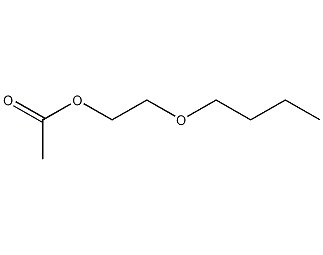
Structural formula
| Business number | 034Z |
|---|---|
| Molecular formula | C8H16O3 |
| Molecular weight | 160.21 |
| label |
2-Butoxyethyl acetate, 2-Butoxyethyl acetate, Ethylene glycol butyl ether acetate, Butoxyethyl acetate, Ethylene glycol butyl acetate, Butyl Cellosolve Acetate, 1-Acetoxy-2-butoxyethane, 2-n-Butoxyethyl acetate, Ethylene glycol monobutyl ether acetate, CH3COOCH2CH2OC4H9, Multifunctional solvents, aliphatic compounds |
Numbering system
CAS number:112-07-2
MDL number:MFCD00009457
EINECS number:203-933-3
RTECS number:KJ8925000
BRN number:1756960
PubChem number:24878229
Physical property data
1. Properties: colorless or light yellow liquid
2. Density (g/mL, 20/20℃): 0.9422
3. Relative vapor density (g/ mL, air = 1): 5.5
4. Melting point (ºC): -64.6
5. Boiling point (ºC, normal pressure): 191.5
6 . Refractive index (20ºC): 1.4200
7. Viscosity (mPa·s, 20ºC): 1.8
8. Flash point (ºC, opening): 88
9. Autoignition point or ignition temperature (ºC): 340
10. Heat of evaporation (KJ/mol): 48.6
11. Vapor pressure (kPa, 20ºC): 0.04
12. Vapor pressure (kPa, 76ºC): 1.33
13. Vapor pressure (kPa, 109ºC): 6.07
14. Volume expansion coefficient ( K-1,10~30ºC): 0.00104
15. Explosion lower limit (%, V/V): 0.5
16. Explosion upper limit (% , V/V): 3.7
17. Solubility: 1.1% dissolved in water at 20°C; 1.6% dissolved in water in 2-butoxyethyl acetate. Can dissolve ethyl cellulose, polyvinyl acetate, polystyrene, etc. It does not dissolve cellulose acetate, polymethyl methacrylate, polyvinyl butyral, etc.
Toxicological data
1. Acute toxicity: Mouse oral LD50: 3400mg/kg; Rat oral LD50: 2400mg/kg;
Rabbit skin LD50: 1500mg/kg
2 . Irritation to skin and eyes: 500mg/24H for rabbit skin, slightly irritating. 500mg for rabbit eyes��Has a slight irritating effect.
Ecological data
Slightly harmful to water.
Molecular structure data
1. Molar refractive index: 42.63
2. Molar volume (cm3/mol): 170.4
3. Isotonic specific volume (90.2K ): 394.8
4. Surface tension (dyne/cm): 28.8
5. Polarizability (10-24cm3): 16.90
Compute chemical data
1. Reference value for hydrophobic parameter calculation (XlogP): 1.2
2. Number of hydrogen bond donors: 0
3. Number of hydrogen bond acceptors: 3
4. Number of rotatable chemical bonds: 7
5. Number of tautomers: none
6. Topological molecule polar surface area 35.5
7. Number of heavy atoms: 11
8. Surface charge: 0
9. Complexity: 102
10. Number of isotope atoms: 0
11. Determine the number of atomic stereocenters: 0
12. Uncertain number of atomic stereocenters: 0
13. Determine the number of chemical bond stereocenters: 0
14. Number of uncertain chemical bond stereocenters: 0
15. Number of covalent bond units: 1
Properties and stability
Avoid contact with oxides and alkali.
Storage method
Store in a cool, ventilated warehouse. Keep away from fire and heat sources. Protect from direct sunlight. Keep container tightly sealed. They should be stored separately from oxidants and acids, and avoid mixed storage. Equipped with the appropriate variety and quantity of fire equipment. The storage area should be equipped with emergency release equipment and suitable containment materials.
Synthesis method
Refining method: Refined by fractional distillation under reduced pressure.
Purpose
Used as solvent.

 微信扫一扫打赏
微信扫一扫打赏

